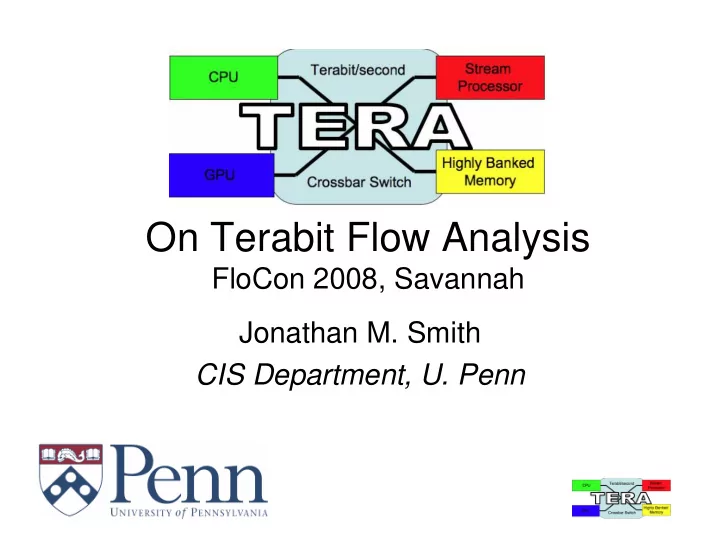

On Terabit Flow Analysis FloCon 2008, Savannah Jonathan M. Smith CIS Department, U. Penn
Terabit Network Applications • Full-fidelity remote visualization and interactive simulation for 80fps HD / 3D HD and beyond, support for holographic visualization • High-speed sensor data from science experiments • Immersive simulations and high-fidelity massively multiplayer virtual worlds • Receive and analyze many concurrent high-fidelity streams of video and/or sensor data - multiple uses in public safety, financial services and other domains
Challenges for Flow Analysis? • New kinds of traffic: – Extremely High Data Rates – Long flows – New patterns with P2P and sensors • Correlation - obtaining the “high ground” – Rare events vs. attenuated sampling? • New analysis possible with DPI • Goal: ingest, record and analyze it all!
Tradespace: data rates vs. analysis The “high ground”: high DSL/3G wireless Consumer FiOS aggregation More 100M Ethernet Nodes plus high 1G Ethernet OC192 data Increasing 100G Traffic Aggregation Increasing ability to processing view / relate / correlate events in real time rates Decreasing # of instructions per byte/sec of throughput
The Terabit Chokepoint Problem/Challenge: Network chokepoint (I/O and memory) between fibers and CPUs
Today’s Single-Core PC Performance Measurements (Using UBUNTU Linux “MEMTEST” utility) L1 Cache: 180Gb/s L2 Cache: 100Gb/s DRAM: 16Gb/s
Challenge of Dense Wavelength Division Multiplexing (DWDM) • Fiber bandwidth is serial bit rate multiplied by number of wavelengths • E.g., 128*40Gbps in deployed systems (128 lambdas of OC768c SONET)
Processing Must Scale with Fiber Capacity • Parallel processing seems necessary • Memory/processing elements to track line rates and number of wavelengths?
Many-Core CPU/GPU Future • Parallelism floodgate unleashed – GPUs and CPUs converging • Teraflop+ performance in 2009 – E.g., 32 cores @ 2Ghz – 16-element “short” vectors 80-core Intel test chip – 100 terabit/sec aggregate register bandwidth – 1 terabit/sec GDDR3 memory bandwidth • How do we feed it?
Technical Approach • Constraints: pins, power, cost • Switch-based interconnects, parallel paths – Direct network/processor interface? • Stream/graphics engines, banked memories – Special high-end pool of DRAMs for NICs? • New software structures for multicore
Components looking good - architecture needed • 1 TB (8 Tbps) memory technologies announced. Fiber good to >10Tb/sec • 80-1000 cores @ 1-10 Gbps each • Major challenges: fiber/electronic boundary, data distribution, interconnection network architectures (see, e.g., Dally+Towles)
Even more processing to scale with fiber capacity? • Parallel processing at both multicore (perhaps NPUs?) and “box” level • Cores track line rates, while degree of “box” parallelism matched against grosser units of wavelengths, e.g., 8:
Advanced Broadband Intrusion Detection Engine (ABIDE) Malice � Interesting Interesting patterns patterns Flow Flow statistics Statistics Scan Scan Flows Flows
Help architects to help you • Computer architects (see Proc. ISCA, Micro, ASPLOS, HPCA, …) evaluate proposals with benchmarks • Media benchmarks are being developed h t tp : / / e u le r . s l u .edu / ~ f r i t t s / med iabench / • Flow analysis needs benchmarks for flow analysis tasks - input side, not just netflow outputs (this is after the fact)
Summary • The future is in parallelism – Dense Wavelength Division Multiplexing (DWDM) – On-chip networks for multicore – Trees for “box”-scale parallelism • Huge challenges remain – Software for new parallelism / media stream analysis; topological choices ( e.g., Batcher-Banyan + Crossbar?); load-balancing algorithms • Need to get flow analysis workloads on computer architecture radar
Acknowledgments • “Terabit Edge Research Activity” (TERA), joint work with Milo M. K. Martin of U. Penn, supported by DARPA/IPTO • “Advanced Broadband Intrusion Detection Engine” (ABIDE), joint work with M. B. Greenwald and E. Lewis, supported by ARO
Recommend
More recommend